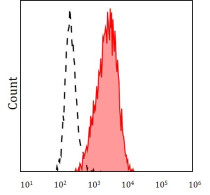ARG44612
anti-HVEM / TR2 antibody [CW10] (PE)
anti-HVEM / TR2 antibody [CW10] (PE) for Flow cytometry and Human
Overview
| Product Description | PE-conjugated Mouse Monoclonal antibody recognizes HVEM / TR2 |
|---|---|
| Tested Reactivity | Hu |
| Tested Application | FACS |
| Host | Mouse |
| Clonality | Monoclonal |
| Clone | CW10 |
| Isotype | IgG1 kappa |
| Target Name | HVEM / TR2 |
| Antigen Species | Human |
| Conjugation | PE |
| Alternate Names | TNFRSF14; TNF Receptor Superfamily Member 14; HVEM; HVEA; TR2; LIGHTR; CD270; ATAR; Tumor Necrosis Factor Receptor Superfamily, Member 14 (Herpesvirus Entry Mediator); Tumor Necrosis Factor Receptor Superfamily Member 14; Herpes Virus Entry Mediator A; Tumor Necrosis Factor Receptor Superfamily, Member 14; Tumor Necrosis Factor Receptor-Like Gene2; Tumor Necrosis Factor Receptor-Like 2; Herpesvirus Entry Mediator A; Herpesvirus Entry Mediator; CD40-Like Protein; CD270 Antigen; HveA |
Application Instructions
| Application Suggestion |
|
||||
|---|---|---|---|---|---|
| Application Note | * The dilutions indicate recommended starting dilutions and the optimal dilutions or concentrations should be determined by the scientist. |
Properties
| Form | Liquid |
|---|---|
| Purification | Purified antibody is conjugated with R-phycoerythrin (PE), and unconjugated antibody and free fluorochrome are removed by size-exclusion chromatography. |
| Buffer | PBS (pH 7.4) and 15 mM Sodium azide |
| Storage Instruction | Aliquot and store in the dark at 2-8°C. Keep protected from prolonged exposure to light. Avoid repeated freeze/thaw cycles. Suggest spin the vial prior to opening. The antibody solution should be gently mixed before use. |
| Note | For laboratory research only, not for drug, diagnostic or other use. |
Bioinformation
| Database Links |
Swiss-port # Q92956 Human Tumor necrosis factor receptor superfamily member 14 |
|---|---|
| Gene Symbol | TNFRSF14 |
| Gene Full Name | tumor necrosis factor receptor superfamily, member 14 |
| Background | This gene encodes a member of the TNF (tumor necrosis factor) receptor superfamily. The encoded protein functions in signal transduction pathways that activate inflammatory and inhibitory T-cell immune response. It binds herpes simplex virus (HSV) viral envelope glycoprotein D (gD), mediating its entry into cells. Alternative splicing results in multiple transcript variants. [provided by RefSeq, Jul 2014] |
| Function | In cis interactions, appears to play an immune regulatory role inhibiting in trans interactions in naive T cells to maintain a resting state. In trans interactions, can predominate during adaptive immune response to provide survival signals to effector T cells. [UniProt] |
| Cellular Localization | Cell membrane, Membrane. [UniProt] |
| Calculated MW | 30 kDa |
| PTM | Disulfide bond, Glycoprotein, Phosphoprotein. [UniProt] |
Images (1) Click the Picture to Zoom In






